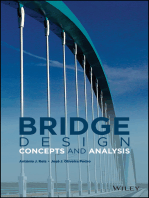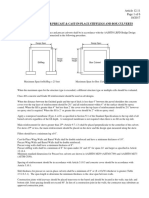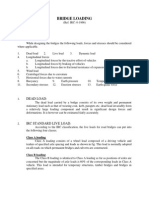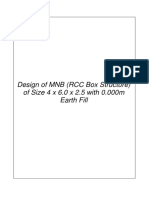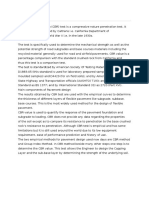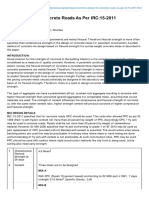Comparative Study For The Design of Single Span Bridge Using AASHTO LRFD and Indian Standard Method
Uploaded by
airpavsetComparative Study For The Design of Single Span Bridge Using AASHTO LRFD and Indian Standard Method
Uploaded by
airpavsetIOSR Journal of Mechanical and Civil Engineering (IOSR-JMCE)
e-ISSN: 2278-1684, p-ISSN: 2320-334X
PP 40-44
www.iosrjournals.org
Comparative Study for the Design of single span bridge using
AASHTO LRFD and Indian Standard Method
Kamde D.1, John B.2 Hulagabali A.3
1
(Applied Mechanics Department, SardarVallabhbhai National Institute of Technology, Surat, India)
(Applied Mechanics Department, SardarVallabhbhai National Institute of Technology, Surat, India)
3
(Applied Mechanics Department, Sardar Vallabhbhai National Institute of Technology, Surat, India)
2
ABSTRACT : This report summarizes the comparative design of a single-span Bridge using AASHTO LRFD
Bridge Design Specification, Indian standard T beam girder Bridge specification and Deck slab (excluding
girders). The writers address the differences in design philosophy, calculation procedures, and the resulting
design. Foundation design and related geotechnical considerations are not considered. The single span bridge
is studied for 10m The significant differences were:- 1)Increased shear Force in IS Method; 2) Increased
amount of Concrete in the deck Portion in IS Method; and 3)Large amount of Reinforcement was calculated in
case of IS Method. For the design of more than 25m span above results were reversed.The design using LRFD
Method is far safer than IS method (with/without Girder) because of special provision for parapet wall along
the bridge. Design procedures under the LRFD Specification tend to be more calculation-intensive. However,
the added complexity of the LRFD Specification is counterbalanced by the consistency of the design philosophy
and its ability to consider a variety of bridges.
Keywords -AASTHO, Bridges, Girder, Load and resistance factor design, IS Method, Spans.
I. INTRODUCTION
The ASSHTO-LRFD Specification uses the word extreme to describe two different items. Article
3.4.1 refers to Extreme Events, i.e., extreme loading events (AASHTO 1998). The Specification requires
checking the deck for vehicular collision with railing system at extreme event limit state. This signifies that, at
this level of loading, damage to structural component is allowed and the goal is to prevent the collapse of any
structural component. It does not necessarily imply that the placement of the vehicle on the curb or sidewalk is
an extreme loading event per Article 3.4.1 (AASHTO 1998).Thus it is engineers judgment to decide whether the
placement of the load on the curb or sidewalk should be included in Extreme Event II (Article 3.4.1) or whether
it should be included in the service and strength limit states (e.g., Service I, Service III, or Strength I). Inclusion
in Extreme Event II is appropriate if the recurrence interval associated with the event is thought to exceed the
design life [2] (Article C3.4.1; AASHTO 1998). Strength I is appropriate if the load event occurs more
frequently; i.e., it has a recurrence interval less than the service life of the structure. The LRFD approach is
reasonable for railings and sidewalks that are installed after the deck is in place and can distribute loads from the
exterior to the interior girders. Although permitted, this approach may not be reasonable for the diaphragms and
the deck itself. Before the deck concrete is set, the concrete is in the plastic state and it cannot distribute these
loads to the interior girders. Therefore these loads were not distributed between the interior and exterior girders
in the LRFD design of the example bridge. The maximum positive moment typically takes place at
approximately the center of each bay. The maximum bending moment varies depending on overhang length and
the value of distribution of dead load[1].The Indian Standard code prescribe that the Deck slab should be
designed for the worst case of either one of the L.R.C. Class AA tracked vehicle, one lane of Class AA wheeled
vehicle or two lanes Class A load train. It is necessary to compute Live Load Bending Moment for all three
cases and take greatest of them. Class AA wheeled vehicle for span less than 4m and Class AA tracked vehicle
for span exceeding 4m. If shear is desired to be computed; Class AA wheeled vehicle is to be considered for
span up to 6m and tracked vehicle beyond 6m. for single lane bridge. [3]the paper summarizes the changes in
design procedure by LRFD Method and compares the results with Design using Indian Standard (with and
International Conference on Advances in Engineering & Technology 2014 (ICAET-2014) 40 | Page
IOSR Journal of Mechanical and Civil Engineering (IOSR-JMCE)
e-ISSN: 2278-1684, p-ISSN: 2320-334X
PP 40-44
www.iosrjournals.org
without girder) for one way bridge deck with span 10m. The comparisons are presented in the order they were
encountered in the design: general design considerations, followed by design of longitudinal girder, shear design
of the girder, deck design, and abutment design. Foundation design and related geotechnical considerations are
not included in this paper.
II. GENERAL DESIGN CONSIDERATIONS
2.1The LRFD design philosophy (Fig 1) provides a common framework for the design of structures
made of steel, concrete, and other materials. However, the flexibility of this approach also increases the
complexity of the process. In general, load and resistance design code is based on structure under rare failure
conditions. It is not as readily applied to other design considerations such as deflections, serviceability, fatigue,
or creep, where behavior is often governed by service loads, i.e., day-to-day loads and deflections. Because of
this difference, there are limit states established specifically for pre stressed girder design.
2.2T-beam bridge is by far most commonly adopted type in span of 10-25 m. This is particularly important
when the design loading consist of concentrated wheel load, such as Class 70 R or Class AA wheeled vehicles,
to be placed in most unfavorable position. The concept of cross beam can be introduced to get reduced
deflection and increasing ultimate load capacity.
2.3Reinforced Concrete deck slab(Fig. 2)b is economical up to depth of about 8m.However construction is
comparative simpler due to easier fabrication of formwork and reinforcement and easy placing of concrete.
Deck slab should be designed for the worst case of either one of the L.R.C. Class AA tracked vehicle, one lane
of Class AA wheeled vehicle or two lanes Class A load train. It is necessary to compute Live Load Bending
Moment for all three cases and take greatest of them.
Fig.1: Basic design philosophy consideration for LRFD Method.
Fig. 2: Vehicular load consideration for IS Class AA Tracked vehicle.
III. DEAD LOAD, DL SHEAR FORCE COMPARISON
LRFD Method
IS Method (without Girder)
Dead Load(Deck)
5.24(KN/m2)
21(KN/m2)
Dead Load(Wearing Coat)
2.39(KN/m2)
1.76(KN/m2)
Dead Load(Girder) Total DL
7.39(KN/m2)
22.36(KN/m2)
IS Method(With Girder)
5.5(KN/m2)
1.76(KN/m2)
61.35(KN/m2)
68.61(KN/m2)
International Conference on Advances in Engineering & Technology 2014 (ICAET-2014) 41 | Page
IOSR Journal of Mechanical and Civil Engineering (IOSR-JMCE)
e-ISSN: 2278-1684, p-ISSN: 2320-334X
PP 40-44
www.iosrjournals.org
IV. PERMANENT DEAD LOADS
LRFD Specification Article 4.6.2.2.1 states that where bridges meet the conditions specified herein,
permanent loads of and on the deck may be distributed uniformly among the beams and/or stringers
[2]
(AASHTO 1998 emphasis added) The LRFD approach is reasonable for railings and sidewalks that are
installed after the deck is in place and can distribute loads from the exterior to the interior girders. These loads
were not distributed between the interiorand exterior girders in the LRFD design of the example bridge.
A comparison on the dead loads for the LRFD design, Indian Standard Design with and without Girder is shown
in Table 1. These results indicate that, compared with the Standard Specification design, the Indian Standard
design(Without girder), which is suggested for span less than 8m, increases the non-composite dead Load by
66%. This result is incorporated with span less than 10m. For Longer span we found LRFD method is far better
than the Indian Standard method. Also Results when compared with Indian Standard Design (with Girder) it is
found that Permanent dead Load in case of LRFD is 88.22% less than that of Indian Standard Design (with
girder).
V. VEHICULAR LIVE LOAD
For the AASHTO-LRFD Method of Deck analysis Minimum distance from the wheel to the adjacent
parapet should be 1ft.Dynamic load allowance 33%.Load factor(Strength I) is 1.75 and multiple presence
factor(Single lane) is to be taken as 1.20[4] . Live load effect for the LRFD(approximate method) may be
determined by modeling deck slab on girders which has to be spaced by using specification from table SA4.1-1
from LRFD Code of bridge design. (Fig3)
Fig. 3: Vehicular load consideration for LRFD Method.
For the Indian Standard Live load calculation Deck slab should be designed for the worst case of either one
of the L.R.C. Class AA tracked vehicle, one lane of Class AA wheeled vehicle or two lanes Class A load train.
It is necessary to compute Live Load Bending Moment for all three cases and take greatest of them. Class AA
wheeled vehicle for span less than 4m and Class AA tracked vehicle for span exceeding 4m. If shear is desired
to be computed; Class AA wheeled vehicle is to be considered for span up to 6m and tracked vehicle beyond
6m. for single lane bridge. (Fig 2)
VI. LOAD FACTOR
In the AASHTO LRFD design philosophy, the applied loads are factored by statistically calibrated load
factors. In addition to these factors, one must be aware of two additional sets of factors which may further
International Conference on Advances in Engineering & Technology 2014 (ICAET-2014) 42 | Page
IOSR Journal of Mechanical and Civil Engineering (IOSR-JMCE)
e-ISSN: 2278-1684, p-ISSN: 2320-334X
PP 40-44
www.iosrjournals.org
modify the applied loads. STable 3.4.1-1,STable 3.4.1-2The first set of additional factors applies to all force
effects and is represented by the Greek letter (eta) in the Specifications. These factors are related to the
ductility, redundancy, and operational importance of the structure. A single, combined eta is required for every
structure. These factors and their application are discussed in detail in Design Step 1.1. In this design example,
all eta factors are taken equal to one. S1.3.2.1 The other set of factors mentioned in the first paragraph above
applies only to the live load force effects and are dependent upon the number of loaded lanes. These factors are
termed multiple presence factors by the Specifications. These factors for this bridge are shown as follows:
STable 3.6.1.1.2-1 loads factor can now be factored by the appropriate load factors and combined to determine
the governing limit states in the pier cap, column, footing and piles
1.
There is no provision of Load Factor in Indian Standard code .
VII. SLAB DESIGN
For bridge design[7] (span 10m, carriage width 7.5m, wearing Course 80mm width of bearing 400mm, kerb
600mm, grade of concrete M-20, grade of steel Fe-415). The LRFD-based design requires #5 at 145 mm
spacing as Transverse reinforcement, #6 bars at 140mm spacing in top layer and #6 at 210 mm spacing also #5
at 210 mm spacing for bottom distribution reinforcement (all bars are of 16 mm diameter).
Using Indian standard (with girder) Method reinforcement required was 16mm diameter bars at 190 mm spacing
as main reinforcement, 8mm diameter bars at 170 mm spacing.16mm diameter bars at 200 mm spacing for
design bending moment in longer span, also for T Beam 8 number of 32mm diameter bars provided in 2 rows, 3
bars of 36mm are bent at support to take up the shear stress at support and 8mm diameter 2 legged stirrup with
spacing of 250mm. (Fig5,6)The Large difference in both designs are found because in IS Method it has been
distinguish the design method for bridge span less than 8m also it was observed that the bridge design for span
10m
was
safe
in
case
if
designed
without
considering
Girders.
Fig 5 Deck Reinforcement at mid span of Girder (IS Method)
International Conference on Advances in Engineering & Technology 2014 (ICAET-2014) 43 | Page
IOSR Journal of Mechanical and Civil Engineering (IOSR-JMCE)
e-ISSN: 2278-1684, p-ISSN: 2320-334X
PP 40-44
www.iosrjournals.org
Fig 6 Cross section at mid span (LRFD Method)
VIII. CONCLUSION
Method
Solid Deck
Slab
T - Girder
LRFD
Reinforcement (Kg)
Deck
Girder
5095.31
N/A
Concrete (Cum)
Deck
75
Girder
N/A
3220.02
3555.4
20.86
19.91
16.48
-
3392.6
-
Wearing
Course (mm)
81.75
81.75
81.75
As It is clearly visible from above comparison that LRFD Design Specification has found to be most
economical of the two methods, Results shows reverse nature in case of larger span but LRFD is more safer
even for larger span. Indian Standard code suggest that the bridges more than 8m span should be designed with
Girders and it was found that for bridge span of 10m is safe in all checks even without Girders so It is needed to
be revise the Indian standard code with one standard Design for all span bridge. For Bridges with larger span
Author suggest that incorporation of bridge design in India also because it has a higher safety factor, more safety
norms. The resulting procedure is significantly more complicated. In general, more load cases are considered,
and in specific design equations more parameters are included. As a result, many of the design calculations can
no longer be readily performed by hand; for these calculations, computer methods are preferred. With the help
of software tools, LRFD design
of this type of bridge is not excessively tedious
Here Author has carried out Comparison for only RCC bridges which may further be extended up to Steel
bridges and pre stressed bridges.
REFERENCES
[1] Richard J. Nielsen, M.ASCE, and Edwin R. Schmeckpeper, M.ASCE, Single-Span Prestressed Girder Bridge: LRFD Design
and Comparison, journal of bridge engineering / January / February 2002
[2](AASHTO). (1996). AASHTO standard specification for highway bridges, 16th Ed., Washington, D.C.
[3 ] Indian Standard: 456-2000PLAIN AND REINFORCED CONCRETE - CODE OF PRACTICE, Bureau of Indian Standards, New Delhi
[4](AASHTO). (1994a). Guide specification for distribution of loads for highway bridges, Washington, D.C.
[5](AASHTO). (1998). AASHTO LRFD bridge design specification, 2nd Ed., Washington, D.C.
[6]Barker, R. M., and Puckett, J. A. (1997). Design of highway bridges based on AASHTO LRFD bridge design specifications, Wiley,
NewYork.
[7]D.J. Victor,Essentials of Bridge Engineering (Oxford and IBH, J.P. House New Delhi, 2007).
[8]IRC: 5, 6, 21, 24, 40-1998 Standard specification and code for practice for road Bridges, Indian Road Congress, 1998.
International Conference on Advances in Engineering & Technology 2014 (ICAET-2014) 44 | Page
You might also like
- Thinking in Systems and Mental - Marcus P. Dawson100% (1)Thinking in Systems and Mental - Marcus P. Dawson306 pages
- Design A RCC T Beam Girder Bridge To Suit The Following Data - Google SearchNo ratings yetDesign A RCC T Beam Girder Bridge To Suit The Following Data - Google Search1 page
- 12.11 Design Guidelines For Stifflegs and Box CulvertsNo ratings yet12.11 Design Guidelines For Stifflegs and Box Culverts6 pages
- Computation of Reaction Factors Using Courbon's Method75% (4)Computation of Reaction Factors Using Courbon's Method2 pages
- Pile Cap of Abutment A1 & A2 (Takarma) - 1No ratings yetPile Cap of Abutment A1 & A2 (Takarma) - 11 page
- Solid Slab Bridge Design Example 39 2015 - 1-3No ratings yetSolid Slab Bridge Design Example 39 2015 - 1-33 pages
- Design Data - T-Girder - Jan 11 - 2017 PDFNo ratings yetDesign Data - T-Girder - Jan 11 - 2017 PDF1 page
- MSS-53 Design of Box Culvert of Size 3.0m X 3.0 Reg.No ratings yetMSS-53 Design of Box Culvert of Size 3.0m X 3.0 Reg.103 pages
- Annexure-1 Abutment Design: Design of Abutment of Steel Composite Bridge at Ch. 396+470No ratings yetAnnexure-1 Abutment Design: Design of Abutment of Steel Composite Bridge at Ch. 396+47016 pages
- Midas Civil RSI Analysis Step by Step v2No ratings yetMidas Civil RSI Analysis Step by Step v228 pages
- SERC - Design Tables For Concrete Bridge Deck Slabs TWO WAYNo ratings yetSERC - Design Tables For Concrete Bridge Deck Slabs TWO WAY71 pages
- Reinforced Concrete Road Bridges: Prof. Nirjhar DhangNo ratings yetReinforced Concrete Road Bridges: Prof. Nirjhar Dhang110 pages
- Effect of Varying Slab Depth of The Skew CulvertNo ratings yetEffect of Varying Slab Depth of The Skew Culvert12 pages
- Detailed Survey Data: Public Works Region, Pune Public Works Circle, SolapurNo ratings yetDetailed Survey Data: Public Works Region, Pune Public Works Circle, Solapur23 pages
- Distributing The Load of Bridges Over The GirdersNo ratings yetDistributing The Load of Bridges Over The Girders28 pages
- Isolated Footing-Check For Base PressureNo ratings yetIsolated Footing-Check For Base Pressure5 pages
- 4x6x2.50 - 4.00m Wide - 0.0mfill - MNB - BOXNo ratings yet4x6x2.50 - 4.00m Wide - 0.0mfill - MNB - BOX63 pages
- Section - 4 Hydrological Study 4.1 General: Page - 1No ratings yetSection - 4 Hydrological Study 4.1 General: Page - 113 pages
- Analysis and Design of Under Pass RCC Bridge0% (1)Analysis and Design of Under Pass RCC Bridge7 pages
- [Practice Periodical on Structural Design and Construction 2008-nov vol. 13 iss. 4] Longinow, A. - Review of Design of Highway Bridges_ An LRFD Approach, 2nd Ed., by Richard M. Barker and Jay A. PuckettDesignNo ratings yet[Practice Periodical on Structural Design and Construction 2008-nov vol. 13 iss. 4] Longinow, A. - Review of Design of Highway Bridges_ An LRFD Approach, 2nd Ed., by Richard M. Barker and Jay A. PuckettDesign2 pages
- Comparative Study of RCC T-Beam Bridge By12No ratings yetComparative Study of RCC T-Beam Bridge By1232 pages
- Geotechnical Analysis: and PV Foundation Design100% (1)Geotechnical Analysis: and PV Foundation Design12 pages
- Tech Spec For Road Bridges PSC-RCC Coposites Volume-IINo ratings yetTech Spec For Road Bridges PSC-RCC Coposites Volume-II242 pages
- Rfid Based Positioning For: MSC Project ReportNo ratings yetRfid Based Positioning For: MSC Project Report88 pages
- Newton-Raphson Method: Chemical Engineering Majors Authors: Autar Kaw, Jai PaulNo ratings yetNewton-Raphson Method: Chemical Engineering Majors Authors: Autar Kaw, Jai Paul25 pages
- RFP - DPR ADB IV-PKg. 1 Bhopal Narmadapuram DivisionsNo ratings yetRFP - DPR ADB IV-PKg. 1 Bhopal Narmadapuram Divisions126 pages
- Mix Design For Concrete Roads As Per IRC152011 PDFNo ratings yetMix Design For Concrete Roads As Per IRC152011 PDF9 pages
- Alpha Factors For 6-Wheel Gears - WG 2005No ratings yetAlpha Factors For 6-Wheel Gears - WG 200536 pages
- A Guide To Airfield Pavement Design 1 PDFNo ratings yetA Guide To Airfield Pavement Design 1 PDF136 pages
- Tax Planning in Case of Foreign Collaborations and Joint VentureNo ratings yetTax Planning in Case of Foreign Collaborations and Joint Venture3 pages
- HDCP 2.3 On DisplayPort Comppliace Test Specification Mar 19No ratings yetHDCP 2.3 On DisplayPort Comppliace Test Specification Mar 19129 pages
- Solved If The Cubic Total Cost Function Described in The TextNo ratings yetSolved If The Cubic Total Cost Function Described in The Text1 page
- Lectures 1 - 10 Introduction To Classical Mechanics: Prof. N. Harnew University of Oxford MT 2016No ratings yetLectures 1 - 10 Introduction To Classical Mechanics: Prof. N. Harnew University of Oxford MT 2016102 pages
- The Karnataka Coop Socities Rules, 2013No ratings yetThe Karnataka Coop Socities Rules, 201356 pages
- Marine Pollution Assignment 2 Inc. Front SheetNo ratings yetMarine Pollution Assignment 2 Inc. Front Sheet2 pages
- BOPPPS Session Plan - Respect For DiversityNo ratings yetBOPPPS Session Plan - Respect For Diversity2 pages
- Habitat The Place Where A Plant or Any Living Thing Lives Naturally AdaptationNo ratings yetHabitat The Place Where A Plant or Any Living Thing Lives Naturally Adaptation6 pages
- Sensors: Evolution of RFID Applications in Construction: A Literature ReviewNo ratings yetSensors: Evolution of RFID Applications in Construction: A Literature Review21 pages
- Murat Khairzhan-Uli Munkin Current Position: Mmunkin@usf - EduNo ratings yetMurat Khairzhan-Uli Munkin Current Position: Mmunkin@usf - Edu5 pages
- 2024 02 6 10 51 09 Statement - 1717305669606No ratings yet2024 02 6 10 51 09 Statement - 171730566960625 pages
- A Short Adaptation of James and The Giant PeachNo ratings yetA Short Adaptation of James and The Giant Peach13 pages
- Design A RCC T Beam Girder Bridge To Suit The Following Data - Google SearchDesign A RCC T Beam Girder Bridge To Suit The Following Data - Google Search
- 12.11 Design Guidelines For Stifflegs and Box Culverts12.11 Design Guidelines For Stifflegs and Box Culverts
- Computation of Reaction Factors Using Courbon's MethodComputation of Reaction Factors Using Courbon's Method
- MSS-53 Design of Box Culvert of Size 3.0m X 3.0 Reg.MSS-53 Design of Box Culvert of Size 3.0m X 3.0 Reg.
- Annexure-1 Abutment Design: Design of Abutment of Steel Composite Bridge at Ch. 396+470Annexure-1 Abutment Design: Design of Abutment of Steel Composite Bridge at Ch. 396+470
- SERC - Design Tables For Concrete Bridge Deck Slabs TWO WAYSERC - Design Tables For Concrete Bridge Deck Slabs TWO WAY
- Reinforced Concrete Road Bridges: Prof. Nirjhar DhangReinforced Concrete Road Bridges: Prof. Nirjhar Dhang
- Detailed Survey Data: Public Works Region, Pune Public Works Circle, SolapurDetailed Survey Data: Public Works Region, Pune Public Works Circle, Solapur
- Section - 4 Hydrological Study 4.1 General: Page - 1Section - 4 Hydrological Study 4.1 General: Page - 1
- [Practice Periodical on Structural Design and Construction 2008-nov vol. 13 iss. 4] Longinow, A. - Review of Design of Highway Bridges_ An LRFD Approach, 2nd Ed., by Richard M. Barker and Jay A. PuckettDesign[Practice Periodical on Structural Design and Construction 2008-nov vol. 13 iss. 4] Longinow, A. - Review of Design of Highway Bridges_ An LRFD Approach, 2nd Ed., by Richard M. Barker and Jay A. PuckettDesign
- Tech Spec For Road Bridges PSC-RCC Coposites Volume-IITech Spec For Road Bridges PSC-RCC Coposites Volume-II
- Newton-Raphson Method: Chemical Engineering Majors Authors: Autar Kaw, Jai PaulNewton-Raphson Method: Chemical Engineering Majors Authors: Autar Kaw, Jai Paul
- RFP - DPR ADB IV-PKg. 1 Bhopal Narmadapuram DivisionsRFP - DPR ADB IV-PKg. 1 Bhopal Narmadapuram Divisions
- Mix Design For Concrete Roads As Per IRC152011 PDFMix Design For Concrete Roads As Per IRC152011 PDF
- Tax Planning in Case of Foreign Collaborations and Joint VentureTax Planning in Case of Foreign Collaborations and Joint Venture
- HDCP 2.3 On DisplayPort Comppliace Test Specification Mar 19HDCP 2.3 On DisplayPort Comppliace Test Specification Mar 19
- Solved If The Cubic Total Cost Function Described in The TextSolved If The Cubic Total Cost Function Described in The Text
- Lectures 1 - 10 Introduction To Classical Mechanics: Prof. N. Harnew University of Oxford MT 2016Lectures 1 - 10 Introduction To Classical Mechanics: Prof. N. Harnew University of Oxford MT 2016
- Habitat The Place Where A Plant or Any Living Thing Lives Naturally AdaptationHabitat The Place Where A Plant or Any Living Thing Lives Naturally Adaptation
- Sensors: Evolution of RFID Applications in Construction: A Literature ReviewSensors: Evolution of RFID Applications in Construction: A Literature Review
- Murat Khairzhan-Uli Munkin Current Position: Mmunkin@usf - EduMurat Khairzhan-Uli Munkin Current Position: Mmunkin@usf - Edu




